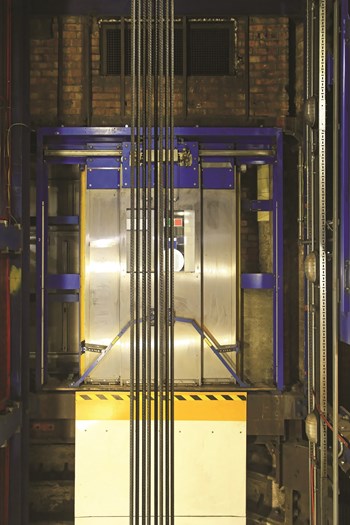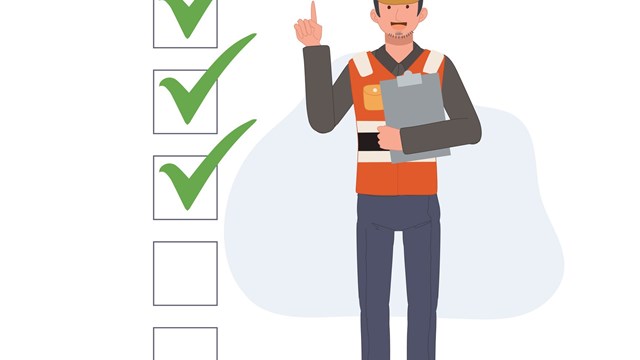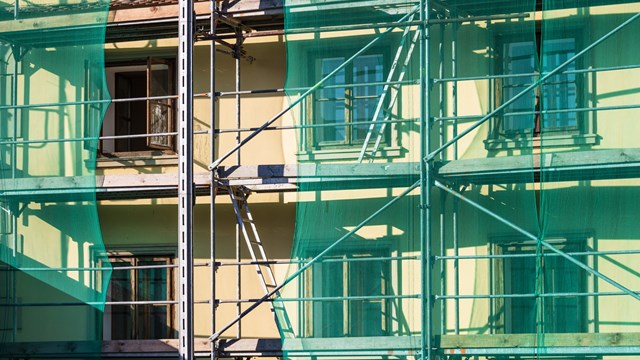
It's easy to take major building features for granted. Consider elevators, for example. A well-maintained elevator can function smoothly for decades, ferrying residents up and down without incident or complaint. Nevertheless, no matter the age of the building, there will come a point where the elevator system will need repair—and possibly even total replacement.
Elevators are convenient, sure—but they're also crucial for residents unable to climb stairs, as well as for deliveries and certain maintenance work. The key to minimizing the disruption of elevator work is identifying signs of wear and tear before a major breakdown occurs.
Useful Life
“While the life span of a properly installed elevator can vary greatly depending on the type of technology and the quality of installation, as a general rule-of-thumb a brand new elevator, or one that has undergone complete modernization, should last at least 25 years before requiring major mechanical upgrades,” says Rene Hertsberg, chief operating officer at Urban Elevator Service in Cicero.
Even if a building owner is diligent with elevator maintenance protocols, there may come a time when the equipment becomes unreliable and the down time is increased, says Suzy Martin, president of Naperville-based Smart Elevators Co.
“Case in point, last week we had a building approach us with a down elevator in a single-elevator building with an elderly tenant,” she says. “Their current service provider could not get the elevator back in operation, so through troubleshooting, we determined a new CPU board for a 1980s elevator controller was needed. The cost for the rushed part was $6,000.00, which is only carried by a single vendor and not in stock.”
Government Oversight
Since it’s not a question of “if” an elevator will need maintenance, but “when” it will require service, the state of Illinois Fire Marshall oversees all elevators processes in the state with the exception within the city of Chicago, explains Craig Zomchek, business manager of Colley Elevator Co. in Bensenville. The City of Chicago’s Department of Buildings, he adds, oversees all of Chicago’s elevator systems.
Every building within the city of Chicago, for example, is required to complete an Annual Inspection Certification (AIC). Whereas devices were once inspected by inspectors from the DOB, building owners are now responsible for having a state-authorized technician inspect respective devices. If a repair or remodel is slated, a permit is required.
“Permits in the suburbs are issued through the township’s building department. Chicago permits are supplied through the Department of Buildings. The suburbs utilize plan reviews from a dozen elevator inspection companies licensed in the state,” says Martin. “The City of Chicago has its own team of reviewers. Mostly, elevator code remains the same at the state and city level. It is the job of a knowledgeable elevator company to handle the permitting and inspection process for you, as code is constantly updating.”
According to the Department of Building’s Rules and Regulations for Annual Inspection Certification of Conveyance Devices, it is the duty of the building owner to submit (online) all required forms and certifications in connection with the AIC program on or before the due date.
“Any building owner who fails to comply with any requirement of this rule shall be in violation of Section 18-30-017 of the Code and shall be subject to a fine of not less than $200 nor more than $500 for each offense as set forth in Section 18-30-430 of the Code. Each day that a violation continues shall constitute a separate and distinct offense to which a separate fine shall apply. Such fine shall be in addition to any late filing fee or other penalty provided by law,” the regulation notes. “In addition, the building identified in such notice and all conveyance devices located therein may be subject to comprehensive inspection by a city inspector. The building owner shall be required to pay any and all fees required to be paid under the Code in connection with such inspection by a city inspector.”
Of Costs and Contractors
If a building deems it necessary to undertake a capital improvement project such as an elevator system; the building not only has to adhere to city codes, but is charged with hiring the right contractor for the job.
“Finding the right company can be a challenge so some buildings choose to hire elevator consultants to help them. Elevator consultants should have knowledge in your elevator system and can make good recommendations on what to replace and what to retain and a set of competent elevator contractors,” says Zomchek. “Also, there are all different sizes of elevator companies with different skill sets. Find a company with a good track record, good references and a good staff that communicates effectively. All elevator companies are not the same—we all do not work on the same equipment and we all have different specialties.”
Depending on the size and scope of the building and its elevator system, there are a wide range of issues related to how old equipment is shut down, dismantled and removed. The manner in which new equipment is brought in, installed and brought online is equally challenging.
“All elevator modernizations will have different timelines from a few days to many months. A building with one five-story hydraulic elevator system can completely modernize their elevator in four to six weeks, a 40-story building with eight times as many elevators can take a few years to complete,” says Zomchek. “The dismantling and removal of elevator equipment for each building is different based on the environment. Sometimes we can use cranes, sometimes we can move the old equipment through the buildings it all depends how the building is set up.”
In some cases, Zomchek explains that machine room walls or ceilings have to be removed in order to access the old equipment. Installing new equipment is similar. Many buildings also have a “scuttle hole” in the elevator equipment room that allows workers to hoist the old equipment out through a lower floor and use the same hole to hoist the new equipment in.
“If it is a project that takes 12 weeks, the elevator mechanics would work on the modernization and follow the scope of work, and when completed with adjusting the new equipment, they would call, say, the city of Chicago elevator inspector, who would come inspect the elevator before turning it over to the building,” says Zomchek. He adds that often trades such as electricians and fire alarm companies are involved. “The elevator company or elevator consultant should walk the building owner through each trade’s responsibilities for a smooth modernization process.”
The costs related to modernize an elevator varies widely based on scope, building conditions and locale. As such, it is difficult to provide actual costs. Hertsberg explains that it is better to look at two different and common types of elevators when considering pricing.
“I would divide it into two general categories: hydraulic and traction elevators. With the caveat that this pricing may not hold true in every part of the country, excluding high-rises and specialty applications, I would give a range of $50,000 to $150,000 to modernize a hydraulic elevator and $100,000 to $300,000 to modernize a traction elevator,” says Hertsberg.
When modernizing an existing elevator system, especially a building with multiple elevators, Hertsberg explains that generally speaking, it is advisable to only work on one elevator at a time in order to minimize the impact on ordinary traffic. The first step is for the elevator contractor to immobilize all the moving parts. The next step is demoing the equipment slated for removal. It is generally the elevator contractor’s responsibility to remove and dispose of all the old equipment.
“Next, your contractor will install the new equipment, which is followed by testing and ultimately inspection by the proper authorities,” he says. “Depending on the vintage of your elevator and the regulations applicable in your jurisdiction, you may be required to add new devices that weren’t previously in your building, such as a fire command panel in the lobby.”
Since the majority of elevators are located inside a building’s interior, the time of year to execute a maintenance project usually isn’t impacted by weather. However, the building’s location and the services offered might be a deciding factor.
“From a contractor’s perspective, it doesn’t really matter what time of year you start an elevator modernization. However, it is important to be aware of any trends specific to your building that may be relevant in deciding how to schedule the project,” says Hertsberg. “For example, if your building has a high rental percentage or is located near a university, it may be advisable not to schedule your freight (or your only) elevator for modernization during times that there are likely to be a lot of moves.”
Managing Residents’ Expectations
If it is determined that elevator maintenance is required, building administrators and board members are required to prepare residents for the inevitable disruptions as well as keep them informed as the project progresses. Whether a repair or a replacement project, experts advise providing as much notice as possible.
“An elevator replacement will affect everyone differently. My suggestion is to get the schedule in writing, and make sure your service provider is sticking to it. Your service provider should be willing to attend a pre-modernization meeting with the tenants to address their specific questions and concerns,” says Martin. “We like to have a kickoff meeting prior to starting work and post a schedule with samples of the new elevator. Also, we have been known to provide the tenants with a ‘pardon our dust’ treat to start the project off on good terms once we remove a piece of equipment from service. The worst thing any manager can do is nothing and deal with it on an emergency basis in lieu of trying to tackle it head on.”
Hertsberg agrees that communication is critical when undertaking an elevator maintenance project. “The building administrators should be briefed on timelines by the elevator contractor or elevator consultant and get regular updates from the appropriate party,” he continues. “There is a significant amount of lead time after the elevator modernization contract is signed and the project begins so the building can begin to prepare residents on the shutdown periods. A good elevator project manager should be available for questions and give the building updates.”
So the bottom line on any elevator replacement or repair project is to communicate early and often with residents and make sure the project stays on track so inconveniences are kept to a minimum.
W. B. King is a freelance writer and a frequent contributor to The Chicagoland Cooperator.






Leave a Comment